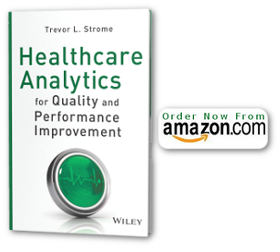 The other day, I was teaching a group of Emergency Department (ED) staff (nurses, healthcare aides, clerks, etc) the principles of Lean. This was part of our ongoing adoption of Lean Thinking in our EDs, and was especially important because of the impending move into a new ED space later this year. By coaching staff in Lean Thinking, we hope to prevent (or at least minimize) some of the headaches of the old department by starting fresh and looking at layout and processes with new eyes.
The other day, I was teaching a group of Emergency Department (ED) staff (nurses, healthcare aides, clerks, etc) the principles of Lean. This was part of our ongoing adoption of Lean Thinking in our EDs, and was especially important because of the impending move into a new ED space later this year. By coaching staff in Lean Thinking, we hope to prevent (or at least minimize) some of the headaches of the old department by starting fresh and looking at layout and processes with new eyes.
Some of the staff had seen Lean presentations before, others were new to Lean. Everybody could, in some way, relate to the principles of Lean. Nobody had problems identifying examples of muda (waste). Unnecessary motion associated with LFS (“looking for stuff”) seemed especially to strike a chord with all the staff (especially tasks like trying to track down charts and equipment).
There was near-unanimous agreement that quality and value need to be defined by the patient. There was really great discussion about the non-value-added steps and time associated with patient care which result, at times, in unnecessarily long lengths of stay. At this point, the discussion shifted to monitoring and auditing processes and applying real quantitative values to important aspects of patient care. Some of the questions were:
- can we measure how long patients wait before being triaged?
- can we measure how long consultants take to respond to a consult request?
- how many patients leave the ED before being seen?
This was the real “ah-ha” moment in the presentation – when the Emergency Department staff were able to identify components of patient care that needed to improve and begin to attach relevant metrics to these components. (Remember, this was only the introductory presentation, not a value stream analysis, so the participants certainly were enthused!) The natural question at this point was, “so, how do we measure these things”?
At this point in the presentation, I introduced our Decision Support System (DSS), an IBM Cognos-based system of real-time dashboards and analytical reports we have developed to support process and quality improvement. The staff could see that real-time snapshots of their department’s performance were available to identify impending bottlenecks and monitor other key metrics as required. The system is also able to provide a full breakdown of they previous day’s activity (patient visits, wait times, and many other key indicators). In essence, we were able to demonstrate that, with the analytics tools at our disposable, that we would be able to support Lean initiatives with data that was:
- accurate
- timely
- easily accessible
- relevant
With accurate and relevant data that is easily accessible, quality champions working on process improvements can monitor the effects of process changes, provide coaching to staff who may not be following the new standards, and make any further tweaks to the process that might be necessary. All this helps with the goal of long-term sustainability of positive process changes and quality improvement. Furthermore, we were able to provide actual evidence from other Emergency Departments in our region who have used our DSS to support Lean and which have realized actual improvements.
At that point, I think, people came to believe that real change is possible. Business Intelligence plus Lean will be a very powerful tool in healthcare.

{ 0 comments… add one now }
{ 1 trackback }